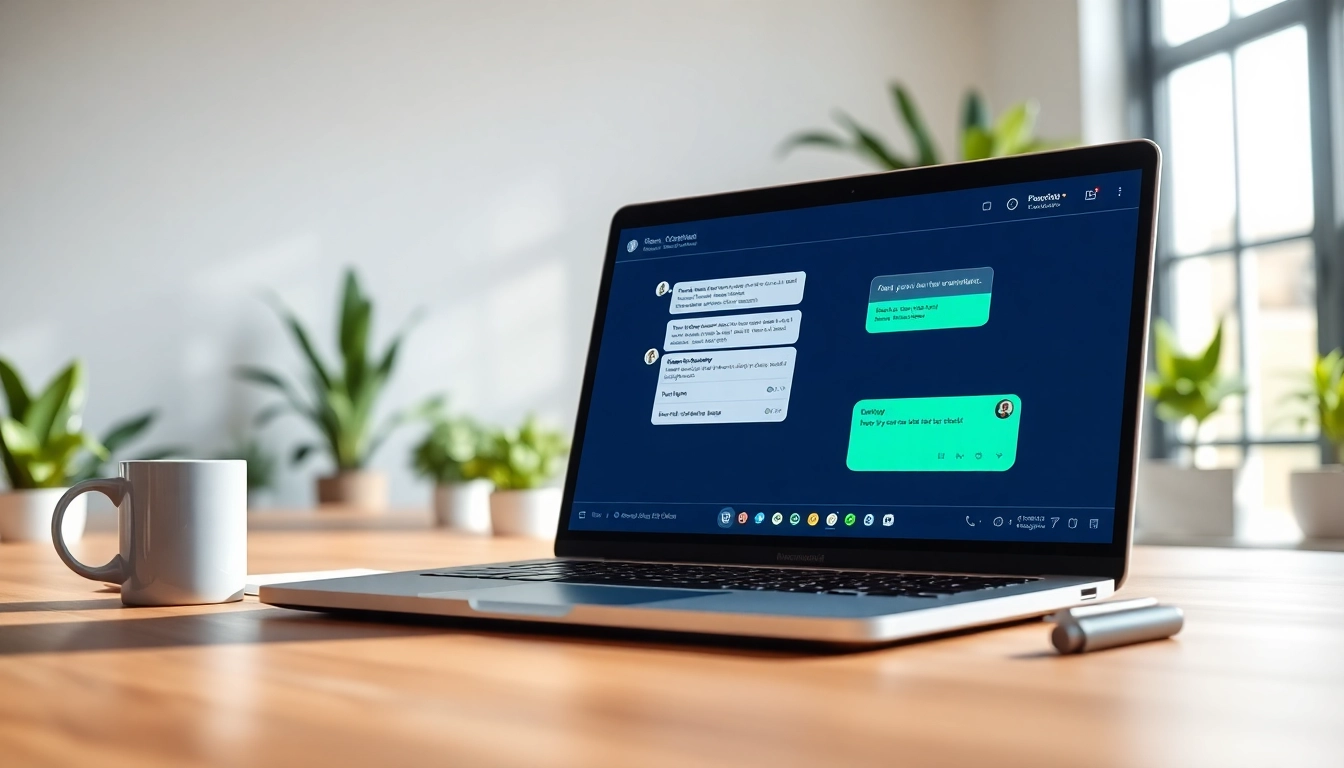Understanding the Importance of a Chatbot for Website
1. Definition and Overview of Chatbots
A chatbot is an artificial intelligence (AI) program designed to simulate human conversation through voice commands or text chats. Traditionally, chatbots were limited to preset responses and simple tasks, but with advancements in AI technology, they have evolved into sophisticated tools capable of handling complex queries and improving user experiences. By integrating a chatbot for website use, businesses can enhance customer interactions significantly, making it a crucial element for modern digital engagement.
2. How Chatbots Improve Customer Interaction
Chatbots serve as the first line of communication for many businesses, providing instant responses to customer inquiries, which enhances user satisfaction and engagement. By operating 24/7, chatbots eliminate wait times, allowing customers to receive assistance when they need it. Furthermore, they can handle multiple inquiries simultaneously, ensuring that no customer feels neglected. This instant assistance can lead to improved customer retention and higher satisfaction rates, crucial metrics for business success in any sector.
3. Use Cases for Businesses
The versatility of chatbots means they can be utilized in various industries. For example, in the retail sector, chatbots can assist customers in finding products, applying discounts, or checking order statuses. In the finance industry, chatbots can help clients manage their accounts, perform transactions, and provide financial advice. Healthcare businesses may use them to help schedule appointments or provide information about services offered. The ability of chatbots to integrate with existing systems and platforms further enhances their usefulness across different business models.
Choosing the Right Chatbot for Your Website
1. Identifying Your Business Needs
The first step to finding the right chatbot for your website is to assess your business needs. Consider factors such as your typical customer inquiries, the volume of traffic your website receives, and your primary objectives for implementing a chatbot. For instance, if your main goal is to drive sales through lead generation, you may need a chatbot configured specifically for that purpose. Alternatively, if you want to enhance customer support, your chatbot should be equipped to handle a wide range of support queries effectively.
2. Comparing Different Chatbot Solutions
Once you’ve identified your needs, the next step is to research and compare different chatbot solutions available in the market. Some popular chatbot platforms include Intercom, Drift, and Chatfuel, among others. Each solution comes with unique features, integrations, and pricing structures, making it essential to evaluate them against your specific requirements. Look for user reviews, case studies, and demo versions to gain a better understanding of how these chatbots work in practice.
3. Key Features to Look For
When selecting a chatbot for your website, here are some essential features to consider:
- Natural Language Processing (NLP): This allows the chatbot to understand and respond to user queries in a more human-like manner.
- Customization: The ability to tailor the chatbot’s responses and workflows according to your brand voice and customer needs.
- Integration Capabilities: Ensure that the chatbot can seamlessly integrate with your existing CRM, email marketing tools, and other platforms.
- Analytics and Reporting: Advanced reporting features will help you measure the chatbot’s performance and make data-driven decisions.
- Multi-Channel Support: A versatile chatbot should be able to operate across different channels such as social media, messaging apps, and websites.
Implementing a Chatbot on Your Website
1. Step-by-Step Integration Process
Integrating a chatbot into your website involves several key steps:
- Choose Your Platform: After identifying your needs and selecting a chatbot solution, the next step is to set up your account with the chosen platform.
- Customize the Chatbot: Personalize the chatbot’s appearance and responses to fit your brand. This may include adding the company logo, selecting color schemes, and configuring default conversational flows.
- Integrate with Your Website: Use the provided installation code or plugins offered by the chatbot platform to embed the chatbot on your website. Make sure it is positioned prominently for user visibility.
- Test the Chatbot: Before going live, thoroughly test the chatbot to identify any issues with its responses, functionalities, and integrations.
- Launch: Once everything is working smoothly, launch your chatbot and inform your customers about its availability.
2. Best Practices for Launching Your Chatbot
Effective launch strategies can significantly impact your chatbot’s success. Begin with soft launches or beta tests that allow a select group of users to interact with it. Collect feedback and make necessary adjustments before a full-scale rollout. Additionally, promote your chatbot’s capabilities through email newsletters and social media, guiding users on how it can benefit them. Incorporate an onboarding process that familiarizes users with the chatbot’s functionalities, ensuring they have a seamless experience.
3. Common Challenges and How to Overcome Them
Implementing a chatbot may come with various challenges:
- Technical Issues: Bugs and glitches can deter user experience. To overcome this, maintain a robust testing and troubleshooting strategy.
- Poor User Engagement: If users find the responses irrelevant, they may abandon the chatbot. To mitigate this, regularly review conversation logs to update and enhance responses.
- Integration Problems: Sometimes, chatbots may not integrate seamlessly with existing systems. It’s vital to choose platforms that are known for their compatibility with your tools and systems.
Measuring the Success of Your Chatbot for Website
1. Key Performance Indicators (KPIs) to Track
Measuring success requires tracking various KPIs such as:
- Chatbot Engagement Rate: The percentage of users who interact with the chatbot versus website visitors.
- Response Accuracy: The rate of inquiries resolved accurately without human intervention.
- Customer Satisfaction Score (CSAT): Post-interaction surveys can provide insight into user satisfaction.
- Conversion Rate: The percentage of chatbot interactions that lead to desired actions, such as purchases or form submissions.
2. Analyzing User Interaction Data
Regular analysis of user interactions can provide valuable insights. Most chatbot platforms offer built-in analytics tools to track user behavior. Pay attention to common questions, peak interaction times, and user abandonment patterns. This data can help you refine your chatbot’s capabilities, ensuring it meets user needs more effectively. Additionally, heatmaps can help visualize where interactions commonly happen on a webpage, offering insights into optimal chatbot position and functionality.
3. Continuous Improvement Strategies
To keep your chatbot effective over time, implement a cycle of continuous improvement. Regularly update the knowledge database to reflect new offerings or common inquiries. Solicit user feedback actively and use this data to enhance your chatbot’s responses and functionality. Finally, conduct periodic reviews to evaluate performance metrics, ensuring your chatbot evolves with user expectations and industry demands.
Future Trends in Chatbots for Websites
1. Advancements in AI Technology
The future of chatbots is heavily intertwined with advancements in AI. As natural language processing (NLP) and machine learning technologies improve, chatbots will become increasingly capable of understanding context and sentiment. This development will lead to more personalized user experiences and improved interaction efficiency, making chatbots invaluable tools for customer engagement.
2. The Role of Personalization
Personalization will be a critical factor in the evolution of chatbots. Organizations will increasingly use user data to customize interactions, providing tailored recommendations and insights based on user preferences and behavior. As a result, chatbots will play a pivotal role in creating memorable experiences, leading to higher engagement and customer loyalty.
3. Predictions for User Engagement
As chatbot technology continues to mature, we can expect to see higher levels of user engagement. Enhanced capabilities will allow chatbots not only to answer queries effectively but also to understand user intent and emulate human-like conversation. This nuance will enhance trust and satisfaction among users, leading to increased adoption rates and greater reliance on chatbots across various sectors.



